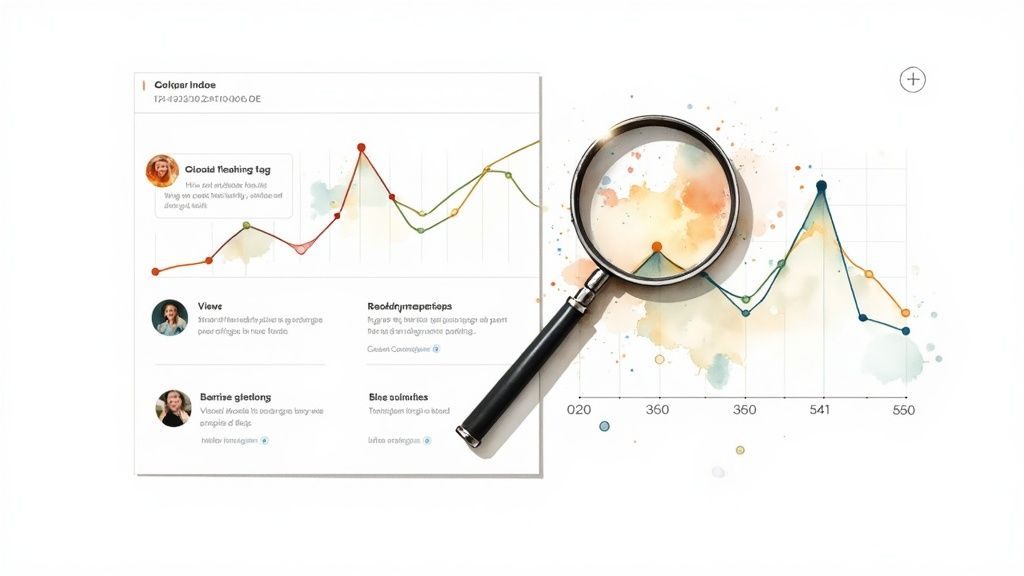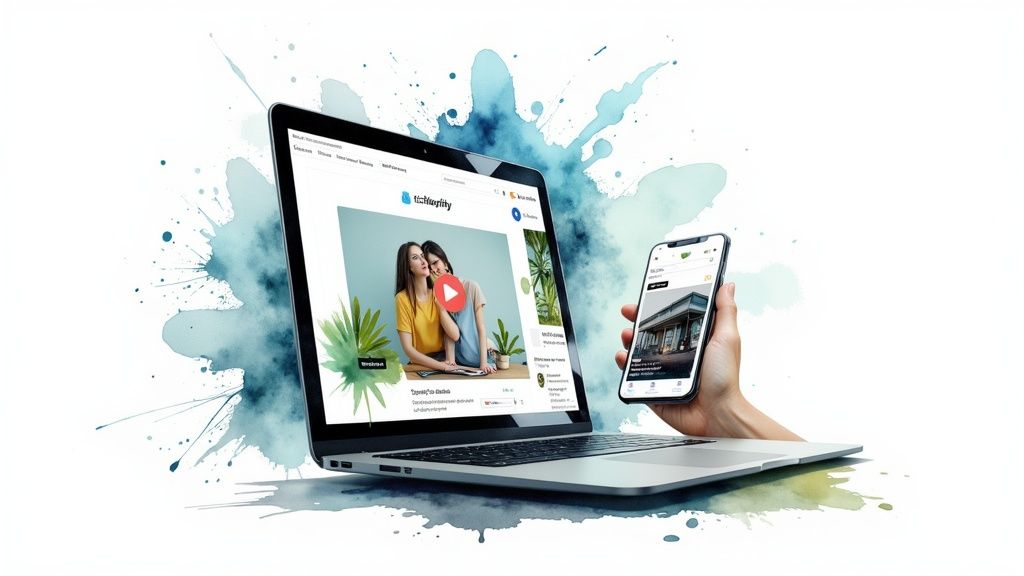Discover how to leverage video on Shopify to boost engagement and drive sales. This guide covers product videos, optimization, and real-world strategies.
In This Article
Subscribe to our newsletter
Adding a video on Shopify isn't just another box to check anymore; it’s a powerhouse sales tool. It builds the kind of trust and shows off your product’s value in a way that static images just can't.
For today's online stores, a great video is what turns a window shopper into a confident buyer. In a crowded market, that's everything.
The Real Power of Video for Your Shopify Store

Let's get past the idea that video is just a 'nice to have.' It’s a core piece of any solid e-commerce strategy. Why? Because it creates an emotional connection with shoppers that a picture, no matter how good, struggles to match.
A well-placed video can answer a customer's unspoken questions, calm their buying fears, and truly bring your product to life.
Think about it from a customer's perspective. They're stuck between two similar products. One has a clear, simple video showing how it works. That's the one that almost always wins. It gives them a real feel for the product's quality, size, and function. This isn't just about showing something; it's about convincing someone.
Building Trust and Boosting Conversions
Video is one of the fastest ways to build instant credibility. Shoppers can see your product in action, hear from happy customers, or get a peek behind the scenes of your brand. That kind of transparency creates a powerful sense of trust.
This isn't just a hunch; the numbers back it up. We’re at a point where 41% of marketers report a high return on investment from their video efforts. Shopify sellers are using everything from quick product demos to heartfelt testimonials to build that crucial trust and, ultimately, drive sales. If you want to dive deeper, you can explore more Shopify marketing statistics to see the full picture.
The bottom line is simple: Video helps customers see themselves using your product. When they can picture it solving their problem or making their life better, clicking "add to cart" feels a lot less like a gamble.
As a bonus, all that extra engagement sends great signals to search engines and can even give you a little boost within Shopify's own platform.
Alright, let's get that video onto your product page. This is where the rubber meets the road, but first, you have a pretty important choice to make. Are you going to upload the video file directly to Shopify, or will you embed it from a platform like YouTube or Vimeo?
Each option comes with its own set of pros and cons that can directly impact your store's performance. While uploading directly seems like the path of least resistance, embedding is almost always the smarter long-term play for protecting your page speed and getting your hands on some powerful analytics.
Choosing Your Shopify Video Hosting Method
It's tempting to just drag and drop a video file into your Shopify product's media gallery—it feels so easy. But be warned: this method puts the full weight of that video file onto your own server, which can seriously bog down your page load times. And since we know that site speed is a massive factor in keeping customers from bouncing, that's a risk you really want to avoid.
Embedding, on the other hand, is a much leaner approach. It lets platforms built for heavy lifting—like YouTube and Vimeo—do what they do best. When a shopper hits play, they're streaming the video from hyper-optimized servers, not yours. This one simple move keeps your product page feeling snappy and responsive.
Before you decide, here's a quick breakdown to help you weigh the options based on what matters most for your store.
Choosing Your Shopify Video Hosting Method
| Feature | Direct Shopify Upload | YouTube/Vimeo Embed |
|---|---|---|
| Page Speed Impact | High (can slow down your page) | Low (minimal impact) |
| Ease of Use | Very easy, just drag and drop | Easy, copy and paste a link |
| Video Analytics | None | Detailed (views, watch time, etc.) |
| File Size Limit | Up to 20 GB | Essentially unlimited |
| Playback Quality | Good | Excellent (optimized for streaming) |
Ultimately, while direct uploads work in a pinch, embedding is the professional-grade choice. It preserves that precious site speed and gives you the data you need to see what's actually working.
Key Takeaway: For nearly every Shopify store, embedding your video from a third-party host is the recommended best practice. It protects your site performance and unlocks valuable viewership data you can't get otherwise.
If you want to get into the weeds on this, our complete guide on how to add video to Shopify covers some more advanced techniques you might find useful.
Getting Your Video Live
Once you’ve made your choice, the actual implementation is a breeze. Just pop into your Shopify admin, head over to the product you want to edit, and look for the "Media" section.
- If you're uploading directly: You’ll add the video file here exactly like you would an image.
- If you're embedding: Click "Add media from URL" and simply paste in the share link from YouTube or Vimeo.
Here's a quick look at where you'll be working inside the Shopify admin. It's pretty self-explanatory.

Shopify has done a great job of making this process feel intuitive, whether you're uploading or just dropping in a URL.
Creating Immersive Storefronts with Video Banners

Going beyond individual product pages, video can completely transform your entire storefront. A dynamic video banner on your homepage is one of the most powerful ways to grab a visitor’s attention the second they land on your site. It instantly sets the mood and tells your brand’s story without a single word.
Think about it. Instead of a static hero image, picture a beautifully shot, looping video of your products in action. If you sell apparel, it could be a model walking down a city street. For a home goods brand, maybe it’s a shot of a cozy, lived-in room. This creates an immediate, immersive experience that a static image just can't compete with.
Technical Steps for Flawless Banners
The real trick to a great video banner is finding that sweet spot between visual impact and site performance. A huge, unoptimized video will slow your site to a crawl, which is a surefire way to frustrate visitors and hurt your SEO. The goal is a short, high-quality, silent loop that loads fast.
First up, you need to pick the right format. MP4 is the universal standard and a safe bet, but I've found that WebM often delivers better compression and quality for its file size. If your theme allows it, providing both lets the browser pick the most efficient one.
As a strict rule of thumb, keep your video under 15 seconds and the file size below 10 MB. Seriously.
Pro Tip: Your video banner doesn't need audio. Muted, autoplaying videos are the standard for a reason—they aren't intrusive and don't ambush your visitors with unexpected sound. As a bonus, stripping the audio track significantly cuts down the final file size.
Most modern Shopify themes, especially on Online Store 2.0, have a built-in "Video" or "Video hero" section right in the theme editor. This is your path of least resistance. You'll usually just need to upload your compressed video file directly into the section's settings, and you're good to go.
If your theme doesn't have this feature out of the box, you might need to look into a simple code snippet or a specialized app. But always check your theme’s capabilities first before you start exploring more complex solutions. Crafting a powerful intro is a core part of a successful video content strategy to boost engagement and conversions.
Making Your Videos Work for You: Performance and SEO
Just dropping a video onto your Shopify store is a great first step, but the real work starts after you hit publish. If you skip the optimization part, that slick new video could actually be slowing down your site and getting completely ignored by search engines. It's the exact opposite of what you want.
Think of it this way: true optimization has two sides. You need to keep your site zippy for visitors, but you also need to make sure Google can find and understand your video. A slow-loading video kills conversions, and a video that’s invisible to search engines is just taking up space. Your goal is to make sure your video is an asset, not an anchor.
Boosting Your Video SEO
Getting your video to show up in search results requires a bit more than just a good title. You have to feed Google the right clues so it knows what your video is about and why people should watch it.
Here’s what I always focus on for any video on Shopify:
- Create a Killer Thumbnail: Your thumbnail is basically your video's movie poster. It needs to grab attention. Design a custom, high-contrast image that makes people curious and clearly shows what the video is about. A great thumbnail can make a massive difference in your click-through rates.
- Write Keyword-Rich Titles: Don't just call it "Product Demo." Get inside your customer's head. What are they searching for? A title like "How to Use Our All-Natural Face Serum for Glowing Skin" is far more effective because it targets real search terms.
- Use Video Schema Markup: This one is a bit more technical, but it’s a total game-changer. By adding video schema (a snippet of code) to your product page, you're explicitly telling Google, "Hey, there's a video here!" This makes you eligible for those eye-catching video results right on the search page.
When you nail these SEO fundamentals, you're not just crossing your fingers and hoping people find your content. You’re actively showing search engines exactly who to show it to. We dive even deeper into this in our guide on why videos are good for SEO.
Protecting Your Site’s Performance
A stunning 4K video is completely useless if it grinds your page to a halt. In e-commerce, site speed is everything, and big media files are usually the number one enemy of a fast-loading page.
Always put performance first with these simple checks:
- Compress Your Video: Before you upload anything, always run your video through a compression tool. This shrinks the file size down, often without any noticeable drop in quality. It’s a must-do.
- Enable Lazy Loading: Make sure your Shopify theme is using "lazy loading." This brilliant little trick stops your video from loading until a visitor actually scrolls down to where it is on the page. It makes a huge difference for your initial page load time.
And remember, video is just one piece of the puzzle. There are plenty of other proven SEO strategies to increase organic traffic that will work hand-in-hand with your video efforts.
Measuring the ROI of Your Shopify Videos

Putting a video on Shopify is one thing, but knowing if it's actually making you money is the real goal. To see if your hard work is paying off, you need to connect the dots between who’s watching your videos and how that impacts your sales. This means looking past simple view counts and digging into the metrics that really matter to your bottom line.
Your first stop should be the analytics dashboard of your video host, whether that's YouTube or Vimeo. This is where you'll find the raw data on how people are interacting with your content.
Don't get hung up on views. Engagement is where the real story is. I'd much rather have a video with 1,000 views and a 90% audience retention rate than one with 10,000 views where everyone clicks away after five seconds.
The key is to track the video engagement metrics that turn viewers into paying customers. To get the most out of your shoppable videos, keep a close eye on watch time, average view duration, and click-through rates. From my experience, and the data backs this up, longer watch times almost always correlate with higher conversion rates. For a deeper dive, check out this excellent breakdown on how video metrics drive sales conversions.
Connecting Video Data to Store Performance
Once you've got your video analytics, it's time to switch over to your Shopify dashboard. What you're looking for are correlations. Did you add a new product video last Tuesday? If so, did you see a bump in that product's performance on Wednesday?
Zero in on these specific changes in your Shopify Analytics:
- Higher Conversion Rates: Is the add-to-cart rate or the final purchase rate for the product higher since the video went live?
- Longer Time on Page: Are visitors who engage with the video sticking around on the product page longer than those who don't?
- Lower Bounce Rates: Is your video compelling enough to stop people from hitting the back button as soon as they land on the page?
By comparing data from your video host and your Shopify store, you create a powerful feedback loop. It won't take long to see which kinds of videos truly connect with your audience and, most importantly, which ones actually drive results for your business.
Common Questions About Video on Shopify
When you start thinking about using video on Shopify, a few questions always seem to pop up. Let's walk through the most common ones I hear from merchants so you can get your video strategy rolling with confidence.
Will Video Slow Down My Store?
This is easily the biggest concern, and for good reason. Will adding videos tank my site speed? The quick answer is: only if you do it wrong.
You should always embed your videos from a dedicated host like YouTube or Vimeo. Trying to upload a raw video file directly to Shopify is a recipe for disaster. Embedding offloads all the heavy lifting to servers built to handle video, protecting your store’s performance.
A slow-loading video is a conversion killer. By embedding, you're not just saving your load times; you're ensuring the video actually gets watched. It streams from an optimized source, keeping your page snappy and your customers engaged.
What Kinds of Videos Actually Work on Product Pages?
For product pages, your video's job is to build trust and answer questions before they're even asked. The most effective videos I've seen are usually pretty straightforward.
Think about creating things like:
- 360-Degree Showcases: Let people see the product from every single angle. It’s the next best thing to holding it in their hands.
- Real-World Demos: Show someone actually using the product. This is huge for helping shoppers imagine it in their own lives.
- Customer Testimonials: Nothing beats a happy customer sharing their experience. This is pure gold for building social proof.
The goal is always to show, not just tell.
Are There Any Platform or Plan Limitations?
Another question that comes up is about access. "Can I even add videos on my Shopify plan?" The answer is a resounding yes.
Every single Shopify plan, from Basic all the way up to Plus, supports video right out of the box. You can add videos to your product media or drop them into theme sections without ever needing to upgrade.
This is a massive advantage, especially when you consider how vital video has become on social media. A staggering 72% of consumers say they prefer to learn about a product through video. If you want to dive deeper, you can discover more insights about video marketing statistics and see just how powerful this trend is.
Turn your existing content into engaging videos automatically with Aeon. Our AI-powered platform makes it simple to create high-quality, on-brand videos that drive results. Learn more and get started at https://www.project-aeon.com.


.jpg)